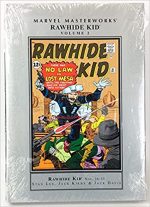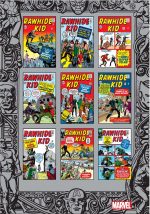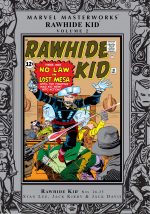


By Stan Lee, Jack Kirby, Jack Davis, Dick Ayers, with Don Heck, Paul Reinman, Al Hartley, Sol Brodsky, Gene Colan & various (MARVEL)
ISBN: 978-0-7851-2684-3 (HB/digital edition)
For most of the 1960s nobody did superheroes better than Marvel Comics. However, even fully acknowledging the stringencies of the Comics Code Authority, the company’s style for producing their staple genre titles for War, Romance and especially Western fans left a lot to be desired. Hints at sex, the venality of authority figures, or using proper guns the way they were meant to be used, capitulated to overwhelming caution and a tone that wouldn’t be amiss in kids’ cartoons or pre-Watershed family TV shows.
Eventually, though, the company’s innate boldness and hunger for innovation overwhelmed common sense. Moreover, and mercifully for revivals of pre-superhero veterans like Rawhide Kid, their meagre art-pool consisted of such master craftsmen as Jack Kirby, Dick Ayers and others…
Technically the Kid is one of the company’s older icons, having debuted in his own title with a March 1955 cover-date. A stock and standard sagebrush centurion clad in a buckskin jacket, his first adventures were illustrated by jobbing cartoonists such as Bob Brown and Ayers but the comicbook became one of the first casualties when Atlas’ distribution woes forced the company to cut back to 16 titles a month in the autumn of 1957.
With Westerns huge on the small screen and youthful rebellion a hot societal concept in 1960, owner/publisher Martin Goodman – via Stan Lee & Jack Kirby – unleashed a brand new six-gun stalwart – little more than a teenager – and launched him in summer of that year, economically continuing the numbering of the failed original…
Crucial to remember is that these yarns are not even trying to be gritty or authentic: they’re accessing the vast miasmic morass of wholesome, homogenised Hollywood mythmaking that generations preferred to learning of the grim everyday toil and terror of the real Old West, so sit back, reset your moral compass to “Fair Enough†and relax and revel in simple Black Hats vs. White Hats delivered with all the bombast and bravura Jack Kirby and his stellar successors could so readily muster…
It all (re) began when Lee, Kirby & Ayers introduced adopted teenaged Johnny Bart who showed all and sundry what he was made of after his retired Texas Ranger Uncle Ben was gunned down by a fame-hungry cheat. After very publicly exercising his right to vengeance, the naive kid fled Rawhide before explanations could be offered, resigned to life as an outlaw…
Reprinting Rawhide Kid #26-35, spanning February1962 to August 1963, this second selection offers another eclectic mix of hoary clichés, astounding genre mash-ups and the occasional nugget of pure wild west story-gold with some of the King’s most captivating and impressive art augmented by significant contributions from a number of other laudable pencil-pushers comprising the first inkling of the fabled Marvel Bullpen.
Following an outrageous introduction by dis-honorary owlhoot Mark Evanier, describing the publishing theories of Publisher Martin Goodman, the bangs for your buck begin with #26 and lead yarn ‘Trapped by the Bounty Hunter’ with Lee, Kirby & Dick Ayers showing how The Kid falls for a smarter man’s snare before impressing him with his honesty and earning another chance. Uncredited prose piece ‘Stagecoach Race’ describes a battle of wits and a risky wager after which comic action turns to melodrama as the ‘Shoot-Out in Scragg’s Saloon’ sees the Rawhide Ripsnorter mistaken by a tragic old man for his missing son. At this time comic books needed to offer a variety of material to qualify for cheaper postage rates and as well as prose shorts would include one generic cowboy tale per issue.
Here, it’s the uncredited ‘Strong Man’ – probably a Lee script limned by veteran by Bob Forgione – which could easily have fitted into one of the company’s mystery titles. Town bully Slade always gets his way but when he steals a mine map he also gets what he deserves…
The issue concludes with The Kid exposing the seeming miracle of ruthless gunslinger ‘The Bullet-Proof Man’…
Rawhide Kid #27 opens ‘When Six-Guns Roar!’, as the restless wanderer finds honest work on a ranch. If only the other hands had welcomed rather than bullied the diminutive newcomer, a lot of violence might have been avoided and history quite different A text story about a ‘Mustang Maverick’ then leads to action-packed hokum as ‘The Girl, the Gunman, and the Apaches!’ finds our hero saving a captive from the repercussions of her idiot father taking pot-shots at innocent Indians after which ‘The Fury of Bull Barker!’ (illustrated by Don Heck) turns the cliché of rough cowboy and slick city dude on its head before Lee Kirby & Ayers reveal how ‘The Man who Caught the Kid!’ had a change of heart and gave the outlaw his freedom…
The team are on top form for ‘Doom in the Desert!’, which opens #28, as the Kid survives a ruthless predator’s trap thanks only to his tragic sister, whilst text treat ‘The Travelling Show’ details a cunning robbery scheme foiled in advance of ‘The Guns of Jasker Jelko!’ Here a circus shootist gone bad is taught a salutary life-lesson by someone used to facing as well as firing hot lead, after which Paul Reinman draws the stand-alone saga of ‘The Silent Gunman’ who taught a town what is more powerful than a fast draw before Rawhide indulges in some relatively gentle remonstration ‘When a Gunslinger Gets Mad!’ Of course, it’s arguably provocation on his part to order milk in a saloon…
Our hero’s perennial search for a little peace and quiet is again scuttled in #29’s opening story as he accepts a dying sheriff’s deal to capture an outlaw in return for a pardon. Sadly ‘The Trail of Apache Joe!’ is long and the battle to subdue him hard and by the time he gets back both the lawman and the deal are dead…
Deceptively anodyne prose vignette ‘Warpath’ segues in to action interval ‘The Little Man Laughs Last!’ as The Kid’s small scrawny physique attracts bullies who soon regret their actions just as Lee & Ayers’ done-in-one diversion ‘Yak Yancy, the Man who Treed a Town’ reinforces the point that brawn does not trump brains, before Rawhide saves a starry-eyed boy from a life of delinquency in ‘The Fallen Hero!’
Rawhide Kid #30 was cover-dated October 1962 and big things were happening. That month also saw the release of Fantastic Four #7; Strange Tales #101 (debut of the Human Torch in a solo series); Tales to Astonish #36 (second costumed Ant-Man); Journey into Mystery #85 (third Thor), and the Incredible Hulk #4 was due four weeks later. Although the company’s standard genre fare was still popular, it was gradually disappearing as Lee reallocated his top creative resources to what was rapidly becoming the “Marvel Age of Comicsâ€. Thus it was approaching High Noon for Rawhide artisans Lee, Kirby & Ayers when hypnotist Spade Desmond rolled into a western town, and his uncanny influence showed everyone what happened ‘When the Kid Went Wild!’, after which an intolerant biddy from “Back East†learns her lesson in prose tale ‘The Silent Man’. The Kid’s ‘Showdown with the Crow Mangum Gang!’ saves an embattled family of homesteaders and Lee & Heck trace the story one particular sidearm in ‘This is… a Gun!’ before his slight stature again gets The Kid in trouble with bullies, and his response triggers a ‘Riot in Railtown!’
Issue #31 replays the theme as a prelude to Rawhide battling a greedy land baron seizing spreads and leading to a ‘Shoot-Out with Rock Rurick!’, after which a mild replay of the war between ranchers and homesteaders is re-examined in cheery text titbit ‘Sheep Run’. The Kid is easily outfoxed and ‘Trapped by Dead-Eye Dawson!’, but earns his freedom thanks to his noble nature, unlike the prodigal brother who features in Lee & Heck’s solo yarn ‘Return of Outlaw!’ Rawhide rides into the wrong town and is jumped by many old enemies in ‘No Law in Lost Mesa!’ before showing just why he’s a legend…
Rawhide Kid #32 (cover-dated February 1963) signalled the end of an era. It opened with Beware of the Barker Brothers!’ as the Kid exposed gunrunners masquerading as local dignitaries and philanthropists and was followed by ‘Home Trail’ – a prose homily on welcoming strangers and a comic advocating guns over gavels in ‘The Judge!’ by Lee & Al Hartley. Kirby’s last hurrah was ‘No Guns for a Gunman!’ as our hero fails to fall for a rigged scam that would leave other gunfighters helpless…
Although he remained as cover artist, this was Kirby’s swan song issue. Ultimately, and via a brief Ayers solo art run, the series would end up as a vehicle for writer/artist Larry Lieber – but before that Lee latched onto another artistic legend who was at that moment in the process of becoming synonymous with America’s favourite humour magazine: Jack Davis.
John Burton Davis Jr. (1924-2016) is probably one of the few strip art masters better known outside the world of comics than within it. His paintings, magazine covers, advertising work and sports cartoons reached more people than his years of comedy cartooning for such magazines as Mad, Panic, Cracked, Trump, Sick, Help!, Humbug, Playboy, etc., but few modern collectors seem aware of his horror and war and western masterpieces for EC, his pivotal if seminal time at Jim Warren’s Eerie and Creepy magazines, and his westerns for Marvel Comics. And that’s a true shame, because they’re quirky but terrific: rough, rowdy, loose and rangy, just like The Kid himself…
Scripted throughout by Lee, three issues of Jack Davis’ bombastic action, comedy and drama begin in #33 (April 1963) with ‘The Guns of Jesse James’, as the perpetually hunted Kid swallows pride and caution and joins the infamous outlaw’s gang. Initially swayed by James’s story of being misunderstood and unfairly accused, Rawhide soon realises he’s been gulled by a master conman and quits in his own unmistakable fashion…
Following the prose fable of a kid finding his place in ‘The Tenderfoot’, Lee & Sol Brodsky play with archetypes in ‘There’s a Shoot-Out Comin’!’ before Davis wraps up his debut with a tale of a young heart broken for the best of reasons in ‘The Gunfighter and the Girl!’
Issue #34 added to The Kid’s growing posse of returning villains as our hero proves utterly unable to beat ‘The Deadly Draw of Mister Lightning!’ however the carnival showman turned gunslinger learns a valuable lesson in their rematch…
Text vignette ‘Bushwacked!’ sees a young man trick his father’s killer into jail before Davis resumes with ‘Prisoner of the Apaches!’ as Rawhide again sacrifices himself to save idiot settlers with no respect for the First Nations. The issue is rounded off with an epic elegiac independent story perfectly capturing that era’s mythology and world view. Crafted by Lee, Kirby, Ayers, ‘Man of the West!’ details one man’s pioneering spirit and achievements. Beautiful and haunting, it’s possibly the most dated and contentious thing in this collection: venerating – like John Ford/John Wayne’s The Searchers – an attitude of exceptionalism and manifest destiny that will appal most modern readers…
Our sagebrush storytelling concludes with Rawhide Kid #35 and another nod to changing times as our hero is inexplicably targeted by a costumed crazy in ‘The Raven Strikes!’ Following a text tale of an old salt proving his worth in ‘Man to Remember’ and a wry rewriting of history by Lee & Gene Colan in ‘The Sheriff’s Star’ everything ends up in a charming tall tale as The Kid overhears boasting bar hounds relating ‘The Birth of a Legend!’ and scarcely recognises himself amidst the blather…
Also included is a bonus cover gallery by John Severin, Gil Kane, Joe Sinnott, Ayers, Frank Giacoia, Alan Weiss, Rick Buckler, Mike Esposito & Larry Lieber of reprint series The Mighty Marvel Western (#17-32; June 1972- June 1974), where many of these tales also appeared.
To be frank, although the art is astounding, the stories here are mostly mediocre. Unless you’re an old school western buff, what’s on offer is derivative, formulaic, occasionally insensitive, and once or twice borderline offensive. If the social climate and your own conscience trouble you, stay away. If, however, you can see this stuff in historical context – created by genuine reformers who pioneered diversity in comics and created breakthrough characters like Wyatt Wingfoot or Black Panther together – take a look. Here is work that stoked the boilers of the Marvel revolution, blessed with some of the very best narrative artwork ever seen.
© 2021 MARVEL.
